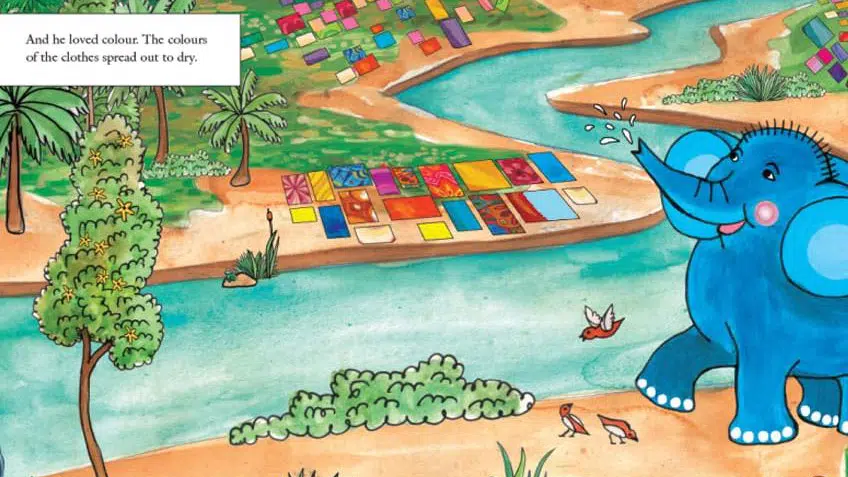“As long as language and people exist, stories will survive”
Arthi Anand Navaneeth is a marketing professional with a fragrance MNC and a writer. Have you seen this? and Ranganna are her picture books published by Tulika. She also is the creator of Mister Muthu for Chandamama. She is a children’s book reviewer at Saffron Tree and a weekend storyteller. She blogs about her storytelling adventures at Art’s Tales and her FB page is www.facebook.com/artstales.
Apart from bookstores, publishers, NGOs, schools and libraries, she has conducted events in establishments such as Kitschdii, Timri, Hamleys, Hundred Hands and Sunday Soul Santhe, to name a few.
She volunteers through Samilksha for the Kidwai Cancer Kids unit and Anand Vidyalaya for Ejjipura slum kids. She was also a storyteller at two Bookalore events, including at the Bangalore Lit Fest 2013 & 2014. She was a storyteller at Neralu – the Tree fest and Cubs of Cubbon 2013.
People have forgotten how listen, tell and share a story. Stories are endangered and, I fear, if not shared will get lost. As a storyteller what are your thoughts on this?
Unfounded fear I think. As long as language and people exist, stories will survive. Their format may change but stories will always thrive. The settings in which stories are told will also change. That is what sets us humans apart from the rest of the species, isn’t it?
Could you tell us a little about how you decided to take up storytelling?
All of us are storytellers – with friends, family, colleagues, clients…As a parent, that role acquires prominence and a conventional dimension.
It was just when I was toying with the idea of turning into a storyteller that I penned and Tulika published my first book “Have you seen this?” After doing a few launch events, I realised I loved kids and storytelling.
A workshop with Jeeva Raghunath came in handy as well as the exposure to book loving parents who are fellow contributors at Saffron Tree (a blog that reviews children’s books).
The illustrator of my first book collaborated with me for the logo and ‘Arts Tales with Arthi Anand’ was born!
Please tell us about your storytelling sessions, audience – a little more about yourself. What is the usual age group of your audience? To which age group do you enjoy telling stories the most?
My story sessions employ multi cultural stories, dance, songs, trivia, art and craft and usually revolve around a theme. Usual age of the audience is 4-9 yrs but I have had senior citizens enjoy sessions too. I enjoy telling stories to those who respond and interact with me during the session (albeit this interaction sometimes becomes too exuberant!). Quiet storytelling is not for me.
What are the learnings you take back from your listeners? Would you like to share any particular experience that stands out?
They help you anticipate questions and prepare answers. Often they share their versions of my story and it is refreshing just to listen to them. Surprisingly even themes which are serious work well with children if we present them well- for example I recently did a story based on the Tsunami.
How do you incorporate sounds and music into your tellings? What is the importance of music in storytelling?
Since I enjoy singing, I do incorporate songs or chants into most stories. It promotes participation and makes the story catchier and memorable. I recall using a Paplu jingle for a ‘Pratham Books’ story. It became a earworm post my sessions.
Do you use elaborate props in your act?
Not very elaborate but a small something to set a context or tone – a dupatta, a banner, a doll or a picture….
What role, according to you, does storytelling play in the classroom? How can it be incorporated in the school curriculum?
Stories stay with you. If one can employ it in a day to day teaching (and learning) then I suppose all subjects would come alive for students. For example most of us recall ‘Unity is strength’ through the story of a farmer using five sticks to teach his quarrelling children the importance of remaining together. Lessons imported through stories and anecdotes remain firm in our minds lifelong.
Could you share your insights on tales from South India. Is there a tale you love telling in particular?
Most stories can be set anywhere with a little imagination and liberty. Until recently my grandmother used to tell my children many folktales in Tamil. I remember the story of the crow with the vadai. My little one still repeats it in Tamil though she speaks very little Tamil otherwise. I remember from childhood the Telugu ditty promises being made to an infant to put it to sleep. More recently my children are taught Kannada songs at school with stories built into them. I also love Gajapati Kulapati from Tulika and The Story and the Song from Karadi Tales. And Ranganna from Tulika of course.
As a storyteller one makes up several stories along the way. Have you documented the stories you create on your own? Do you plan to publish them?
Yes I document them. But publishing them is another story altogether! Stories liked by children do not always appeal to publishers!
Could you please tell us something about Ranganna? and Have you seen this? Are you planning to write any more books?
I am very proud of the Mister Muthu series I wrote for Chandamama targetting older kids. This would have to be considered my first published work.
Have you seen this? is my first picture book from Tulika Publishers. It is a quixotic take on how things could be. It is not a regular tale and requires interactive telling.
Ranganna was created to alleviate my little one’s fear of elephants. Like most elephants, Ranganna is charming and along the way you learn an animal fact as well. Infotainment that is brilliantly illustrated by Kavita Singh Kale. Tulika Publishers brought it alive!

